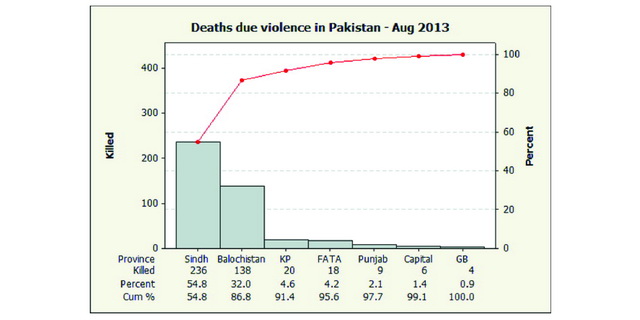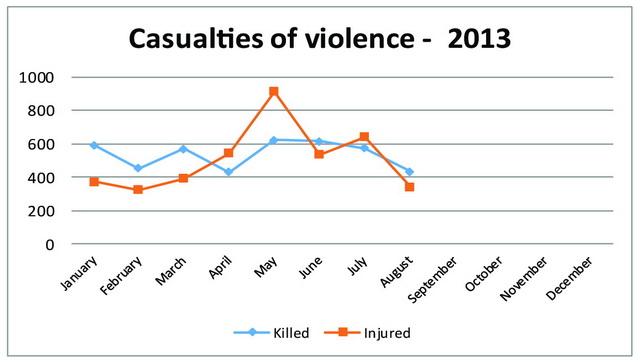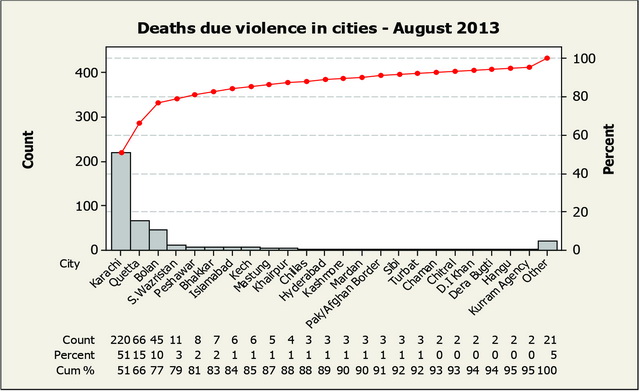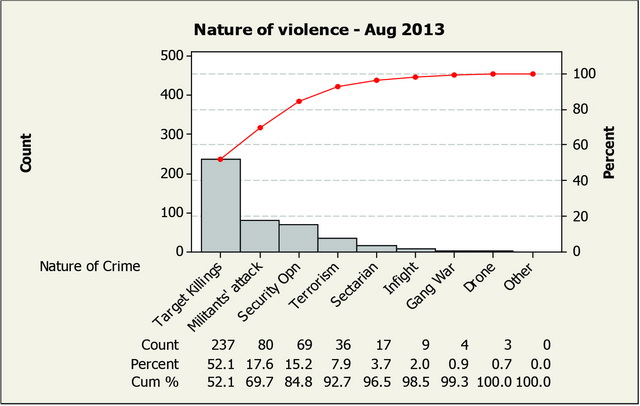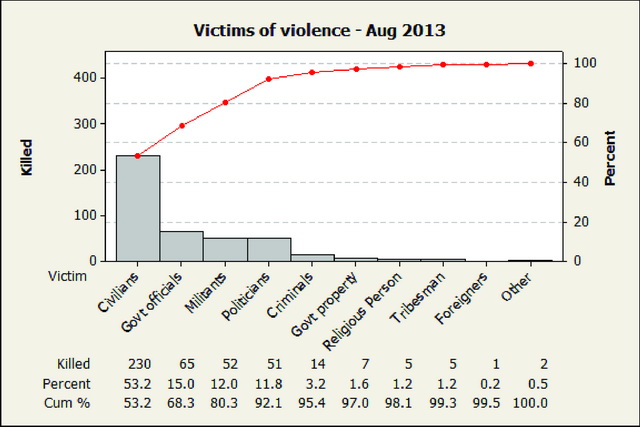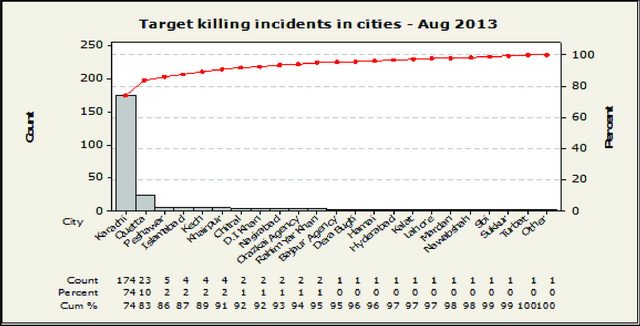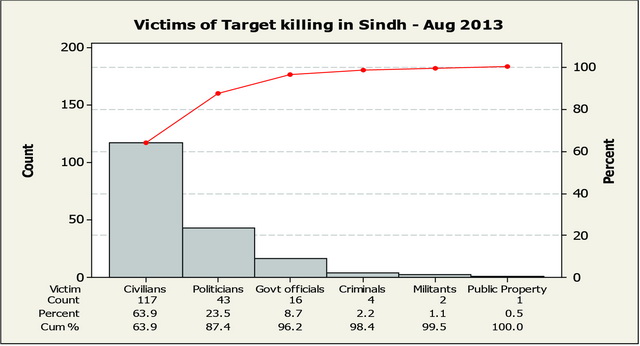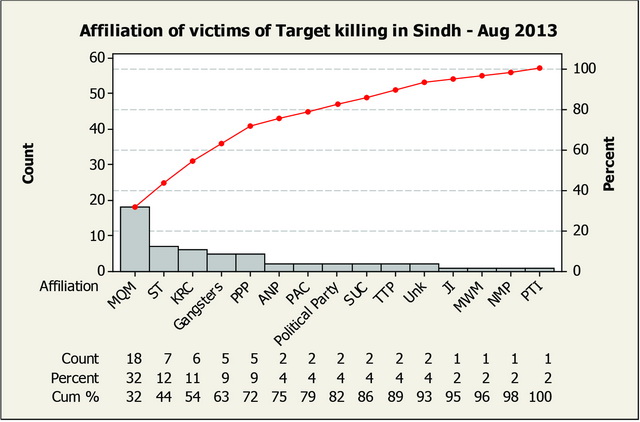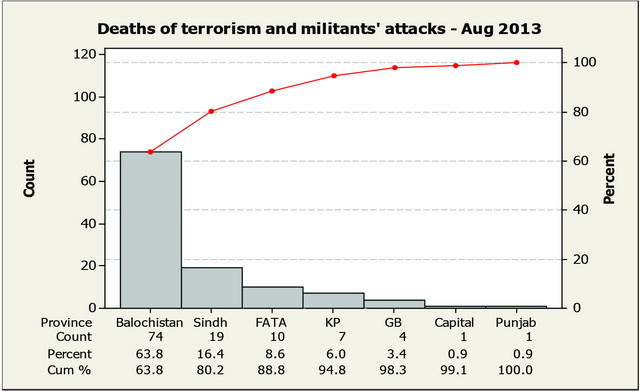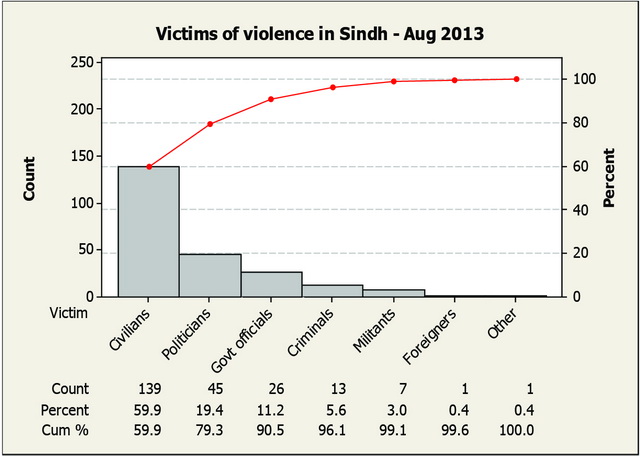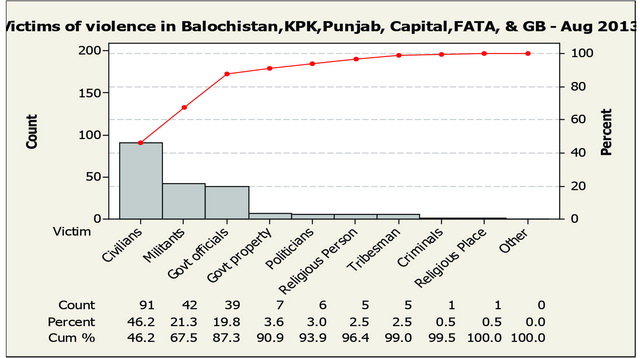The month of August witnessed a mixed scenario of successes and failures in terms of tackling the violence and bringing peace to Pakistan. Two worst-hit regions of the country saw a significant decline in violence while the other two experienced a sudden surge in violent acts. For the people of Bara subdivision of Khyber Agency, the reopening of several roads that were shut down for almost four years was a major relief and news of great jubilation for residents there. For a long time, the region was under the control of the Lashkar-i-Islam and it took four years for a military operation to clear Bara from the militants[1].
In Mohmand Agency, the people celebrated completion of the successful military operation against militants. While inaugurating Yadgar-e-Shahuda (Martyrs– Monument) on 17th August 2013, the Frontier Corps Inspector General Major General Ghayoor Mehmood proudly announced that the writ has been restored in Mohmand Agency[2]. Having endured militancy and resultant displacement for over a decade, the Tribal Elders of Mohmand and Bajaur regions convened a jirga of different tribes and urged local residents to forge unity to thwart the designs of anti-peace elements[3].
Amid these success stories came the sad reports of Eid Day massacres of innocent when two suicide attacks, shamelessly claimed by the Taliban, killed 48 persons and wounded 55 others in Quetta[4] [5].Prior to this horrifying incident, a group of 200 armed persons of Balochistan Libration Army (BLA) had a field day on 7th August 2013 in Machh of Bolan when they carried out their sinister operation of slaughtering 14 persons after kidnapping them from the passenger buses which were on route to Punjab from Quetta[6].
However, the brighter part of the month was that the total number of casualties stood at around 432, the lowest for the whole year. Until August, the average monthly death toll was nearly 530.
All these events and other facts reported in the national newspapers are collected to make this report as informative and factual as possible. Errors and omissions, as always a possibility in all statistical works including this one, are expected. However, such mistakes do not grossly affect the basic objective of the report, which mainly covers the following topics:
Target killings
Militants– attacks
Terrorism
Security operation
CRSS will appreciate receiving comments that the readers may have on this report.
Report prepared by:
Mohammad Nafees
Senior Research Fellow
Center for Research and Security Studies
Data compilation by:
Fariha Farry
NOTE: Readers can approach CRSS for source of any information included in the report. Please send your request to: [mail@crss.pk]
OVERVIEW
Deaths due to violence in the country during August 2013:
During the month of August, many indicators of violence saw unprecedented changes. The total casualties of violence came down to 774 (432 deaths and 342 injuries) from 1214 for the last month. It was a very sharp decline and the following graph of violence shows a downward trend from June 2013 onward.
(Refer Graph 1 and Table 1 below).
Graph 1: Casualties of violence 2013
Table 1: Casualties of violence 2013
|
Month |
Killed |
Injured |
Total Casualties |
|
January |
591 |
373 |
964 |
|
February |
454 |
324 |
778 |
|
March |
570 |
392 |
962 |
|
April |
429 |
544 |
973 |
|
May |
622 |
914 |
1536 |
|
June |
616 |
535 |
1151 |
|
July |
572 |
642 |
1214 |
|
August |
432 |
342 |
774 |
Another significant change in violent incidents is observed in Khyber Pukhtunkhwa (KPK) and FATA regions where the cumulative number of deaths at both places was only 38 compared to 295 for the previous month, a reduction of almost 80% (Refer Graph 2). As compared to KPK and FATA, the acts of violence almost doubled in Balochistan in August (138 against 75 for the last month) while in Sindh it experienced 40% increase in number of deaths due to incidents of violence (236 against 195 for the last month in Sindh). Can this change be attributed to the successful military operation in FATA or to the new provincial government formed by the coalition of two political parties – Pakistan Tehreek-e-Insaf (PTI) and Jamat-e-Islami? It will be too early to make such a conclusion based on one month experience. However, it is interesting to note that the two provinces, Punjab and KPK with local government having reputation of being mild towards militants, have now achieved a relatively peaceful situation compared to the other two provinces ´ Sindh and Balochistan. Coincidently, the provincial governments in Sindh and Balochistan are left-oriented and have little or no inclination towards religious fundamentalism.
Major causes of violence remain unchanged with target killings staying as the highest reason for deaths in the country followed by militant attacks (Refer Graph 4) [Note: Instead of placing all suicide and militants– attacks under the category of ‘Terrorism’ we have started now placing these two incidents under ¿militants– attack’ category which seems to be more appropriate in singling out these happenings.]. The districts highly affected of violence were Karachi, Quetta, and Bolan (Refer Graph 3). Besides the civilians as the highest victims of violence the next highest victims were government officials (including soldiers, levies, policemen, and other administrative government officials). Militants and politicians (political leaders, parliamentarians, and activists) were the other two major victims of violence during this month (Refer Graph 5). Last month, the number of politicians killed was 47 that went up to 51 while the number of militants eliminated last month was 144 compared to 52 killed during this month. The reasons could be the reduction in militant attacks on security forces. Refer to Monthly Report ´ July 2013 for the figures of last month.
Graph 2: Number of people killed in provinces due to violence:
Graph 3: Number of persons killed in cities:
Graph 4: Nature of violence in Pakistan ´ June 2013
Graph 5: Victims of violence in June 2013:
To understand the causes and different factors involved in triggering the violence in the country, a detailed review of different indicators is necessary.
Target killings:
Graph 6: Victims of violence in June 2013:
Target killing is a method of violence commonly used by different militant groups and criminal outfits. No province is safe from these crimes and the highest victims of such incidents are in Sindh (particularly in Karachi). Other than many criminal organizations, the political parties are also accused for having their hands in crimes like target killings in the country. DG Rangers, Major General Rizwan Akhtar accused the militant wings of political parties for the ongoing bloodshed in Karachi[7].
Target killings and other causes of violence became main focus of the government, the media, and the judiciary during this month while the incidents of terrorism took secondary place. It all happened in a strange way. The month of August began with a feeling of remorse and discouragement for the security agencies as an aftermath of the blatant militant attack against the main jail in D.I. Khan on 30th July. Soon after the incident, a blame game ensued among local government and different security departments that ended nowhere other than finding faults within the system that remained highly ineffective or complicit in letting the militants complete their tasks with all ease and comfort they might have not expected. Shocked and surprised on a repeat of the previous jailbreak incident in Bannu, the media started mocking at the performance of the security guards at the D.I. Khan jail who, instead of resisting the attack, welcomed the militants by opening all the gates when they reached there[8]. Even the Provincial Revenue Minister, Ali Amin Khan Gandapur of KPK called the incident an act of cowardice on part of local police[9]. Imran Khan of PTI openly blamed Pakistan Army for the incident saying, ‘terrorists succeeded in breaking the Dera Ismail Khan jail although one division of the army was present in the city[10].’
To enhance the ongoing confusion and bickering among the government officials and political leaderships, the militants made another attempt to attack heavily guarded Chaklala Base of Pakistan Air Force on 3rd August, 2013. According to reports, nearly 18 militants dressed in police uniform riding in three high-roof made look-like police vehicles, having revolving lights and fitted with sirens were intercepted at the main enterance of the airport. Luckily, they failed to accomplish their task but managed to flee from there without getting arrested[11].
While the country was debating these shameful violations of the writ of the government, the newly elected Pakistan President Mamnoon Hussain told the BBC Urdu; ‘.. .whenever he thinks of resolving the law and order issue of the country his mind comes to Karachi first[12].’ A couple of days later, on 4th August, Karachi witnessed targeted killings of five policemen by suspected militnats belonging to banned outfits[13]. On 6th August, another brazen militant attack on a team that was investigating the June 23 killing of foreign climbers resulted in the death of a SSP and two army officers (Colonel Ghulam Mustafa and Captain Ashfaq Aziz) in Gilgit-Baltistan Chilas area[14].
Amid these incidents of target killings and militant attacks, the ongoing border conflicts between India and Pakistan got accelerated on 5th August 2013 when India accused Pakistan Army of tresspacing the Line of Control in Kashmir and killing five Indian Army personnel. Reporting the incident, the Hindustan Times said, ‘..an unsuspecting Army patrol walked into an ambush by 15 to 20 men, wearing Pakistan Army uniform, close to Sarla and Chhaja posts[15].’ Whether or not the Indian claim was correct, it was a reminder of how the militants wearing police uniforms had attacked the D.I. Khan jail[16]. The steps Nawaz Sharif government had taken to develop good friendly relations with India suffered badly and those who were actually behind the killing of Indian army personnel were very successful in leading the two countries away from each other.
A couple of days later, on 7th August, 2013, the insurgents in Balochistan killed 14 passengers by intercepting several buses going to Punjab from Quetta. The same day, a bomb explosion at a Football Stadium in Lyari killed eight, including football players and other people[17]. The two most tragic and fatal incidents of the month took place on Eid Day in Quetta when four gunmen sprayed 10 persons with bullets while they were coming out of the mosque after offering Eid prayers[18]. On the same day, a suicide attack on Police Headquarters killed 38 persons, including DIG, DSP, and SP attending funeral of a SHO who was killed by the militants earlier in the day. The Taliban claimed it was behind the attack[19].
Jolted by these deadly attacks, the government came out with strong worded condemnation and the media also expressed views that recommended suppression of the elements suspected to have been involved in the violence. Interior Minister Chaudhry Nisar Ali Khan sought unity of the people in confronting the threat of militancy in these words: ‘The entire nation should be on the same page in the `war against terror– as it has now become a battle for survival of Pakistan even though it was imposed on us. [20]‘
The editorial published by The News on 12 August 2013 recommended: ‘The Nawaz government was keen to pursue talks with the TTP but with every additional attack the prospect of getting the militants to cease their violent ways seems ever more unrealistic. Not only do we need to crush the TTP in the areas they control, we will have to back it up with a plan to reduce fresh recruits for militant groups by increasing economic opportunities in those areas[21].’
The government started talking of making National Counter Terrorism Policy (NCTP) for the country and seeking unity and joint efforts of all the stakeholders. The long awaited APC became important once again and it was rescheduled at the end of August. While the government was talking of ¿war against terror–, a column written by Ahmad Hassan appeared in The News on 15th August 2013 that suggested the PML-N government to avoid taking a complete U-TURN on their anti-terror policy especially at a time when the US is trying to bargain a truce with the Afghan Taliban. The column also carried a comment from the former ISI chief Gen. Hameed Gul that said: ‘… what the interior minister has outlined in his news conference is no solution at all, adding they should accept failure of agencies in producing a set policy to tackle the scattered but well trained militants’, citing example of D.I. Khan jailbreak. ‘The anti terror policy, [he added] should realise this and the government should enter into dialogue with the group that is pro-Pakistan and which is supportive of peace talks with Islamabad[22].’
Coincidentally, on the very same day, the Taliban also announced that they were ready for talks and go for war as well if the government wanted so. In the same statement, they also warned India saying ‘If India does not stop firing along the LoC in Azad Kashmir, we will also target Indians and will defend Pakistani borders.[23]‘ What led them to take this position if they had no link with the event that resulted in the killing of five Indian soldiers is a question that can be left to the guess work of our intelligence agencies and analysts. Maualana Fazlur Rehman, chief of JUI-F also made suggestions that favored dialogue with the militants instead of going out for war saying, ‘.. the solution lies in quickly getting out of this war and the way forward is not the use of force but dialogue with the Taliban[24].’
Nearly a day later, armed militants killed four passengers and injured another 27 in a rocket attack at Jaffar Express on 16th August, 2013 in Bolan, resulting in a security operation that ended after death of eight militants[25].
Infuriated by these acts of violence in Balochistan, the Railways Minister Khawaja Saad Rafique stated that, ‘…[The] government offer for dialogue should not be taken as a weakness as a rocket fired at the people or forces would be retaliated with 10 rockets’. He went ahead and warned that ‘anybody taking up arms against the country cannot be negotiated with, unless they lay down their weapons and agree to talk peacefully. If anyone resorts to firing a rocket at the people or at the forces, it will be retaliated with ten rockets.[26]‘
On 19th August, 2013, Prime Minister Nawaz Sharif offered dialogue option to the ¿armed militants– when he addressed the nation. ‘The government has more than one options to deal with the problem of terrorism, but wisdom demands a cautious way in which no more lives of innocent people are lost as the country has already suffered 40,000 causalities of both civilians and security personnel[27].’ Instead of showing a firm resolve to stand against the militancy he started telling the nation as to how weak and inefficient the security and law implementation system is. ‘Even if these extremists are arrested, those who arrest them seem scared and don–t investigate them on professional lines. And when these cases are presented before courts, judicial officers are reluctant to take them. Out of fear, witnesses also don–t come forward.’ In the same speech he also made a brief mention of the violent situation in Karachi. ‘Karachi could not be allowed to be lost to terrorism[28].’
On 23rd August 2013, the Information Minister and Government Spokesman, Pervez Rashid, made an addition to the dialogue offer. ‘The dialogue offer announced by the Prime Minister had no pre-conditions attached and it remains so even today[29].’ Feeling satisfied with such a reassurance from the corridor of power, the commander of banned Tehreek-i-Taliban Pakistan welcomed the peace talk offers by the government[30]. On 25th August, 2013, Interior Minister Chaudhry Nisar Ali Khan reaffirmed the government position on dialogue, ‘Our priority is dialogue, and we don–t want to talk of anything else right now.[31]‘ Missing in these statements were the resolve and boldness exhibited earlier by the government in dealing with militants in Balochistan when Railway Minister Khawaja Saad Rafique had warned them of shooting ten rockets in retaliation to one and having no negotiations with the militants who don–t want to lay down their arms.
A couple of days later, addressing a gathering at a dinner reception here at Karachi Chamber of Commerce and Industry (KCCI), the President-elect of Pakistan Mamnoon Hussain said that ‘…most heinous crimes take place in Sindh, particularly in its port city, Karachi[32].’ In a very surprise move, the MQM chief Altaf Hussain asked the government to hand over Karachi to army under article 245 of the Constitution[33]. The parliamentarians went berserk hearing a democrate demanding military operation in the largest city and commercial hub of the country. The deteriorating law and order situation made the Chief Justice (CJ) Iftikhar Muhammad Chaudhry to say, ‘…the Police and Rangers had failed to ensure the law and order situation in Karachi and the government writ in the port city had been reduced to zero[34].’
A new consensus on improving law and order situation in Karachi began emerging among different political parties and government institutions and the media also began focusing on it with as much vigor as it could to prove that it is the violence in Karachi that needs to be addressed first. Ultimately, the most trumpeted all parties conference on national security and terrorism became a secondary issue. Writing on the subject, Tariq Butt, a columnist of The News, made this observation, ‘A national consensus seems around the corner on launching a targeted operation against identified target killers, extortionists, criminal gangs and mafias to rid the people of Karachi of the nightmare they have been facing since long[35].’ The fear of an impending operation in Karachi might have led the criminals and militants to use their intimidating tactics to force the government to stay away from them that resulted in a surge of violence in Karachi during the month of August when 75% victims of target killings in the country were reported in Karachi alone (Refer Graph 7)
Graph 7: Target killings in cities:
Target killings in Sindh:
According to data, 95% of target killings in August 2013 took place in the provincial capital of Karachi while other cities of Sindh, including Khairpur, Hyderabad, Nawabshah and Sukkur also suffered such incidents during the month. The highest victims of target killings after civilians were the political activists and supporters (Refer to Graph 8).
Graph 8: Victims of target killings in Sindh:
Banned militant organizations like TTP took its root in Karachi and they carried out a suicide attack on a military convoy in Korangi on 23rd August 2013 leaving one soldier dead and 10 injured besides killing one civilian and wounding five others. Earlier, a 15-year-old suicide bomber hailing from South Waziristan was arrested from Kunwari Colony in Maghopir[36]. A rivalry between two groups of the banned TTP also resulted in target killings of several persons belonging to Wali-ur-Rehman and Hakimullah Mehsud groups. According to a report appeared in The News on 21 August 2013 ‘…Kunwari Colony in Manghopir has become a stronghold of TTP militants in Karachi and 11 militants of the Sher Khan group, which used to represent Hakimullah Mehsud in Karachi, have been killed by their rivals during the last four-five days.[37]‘
During this month, 122 persons were gunned down and 60 dead bodies were discovered from different locations in Karachi. Among the victims of target killings, there were 43 political activists and supporters with majority of them belonged to MQM (Ref Graph 9)
Graph 9: Violation of the victims of target killings in Sindh:
Target killings in Balochistan:
The next higher number of victims of target killings after Sindh were in Balochistan and 65% of the victims were from Quetta city while the rest were from Kech, Nasirabad, Dera Bugti, Harnai, Sibi, Turbat, and Zhob (Refer to graph 10). Besides the majority of civilian victims, there were government officials (one SHO and four policemen), three Tribal elders, and two religious persons. Most of the victims were gunned down and there were seven victims whose dead bodies were found from different locations of the province. A former senator Ismail Buledi belonging to Jamiat-ul-Islam escaped an assassination attempt in Turbat on 17th August, 2013.
Graph 10: Violation of the victims of target killings in Sindh:
Target killings in KPK and FATA:
The number of persons died in KPK and FATA as a result of target killings was only 13 out of which 10 were from KPK. Peshawar city had the highest victims (5 persons) followed by Chitral (2 ea), D.I. Khan (2 ea) and one in Mardan. There were three prominent persons among the victims. A woman leader of the Awami National Party (ANP), Najma Hanif Jadoon, who was a candidate on reserved seats for women was shot dead inside her house in Hayatabad on 2nd August, 2013. Two years earlier, Najma spouse Hanif Gul Jadoon, a former Tehsil Nazim, was killed along with a 16-year-old son and a gunman in a suicide attack on his car in Swabi on the Eid day in November 2011.
On 1st August, the Station House Officer of Daudzai Amir Sultan and his driver were killed when unknown militants ambushed their vehicle on Aryana Road on the outskirts of Peshawar.
On 1st August, the Intelligence Bureau (IB) official, Mazhar Hussain who was injured in an attack a day earlier, succumbed to his injuries in the hospital.
In Chitral, a place hitherto known as peaceful, a psychologist and an insane patient in office of Agha Khan Health Services were targeted by unknown assailants on 27 August 2013.
In FATA, Bajaur agency lost renowned tribal elder Ajab Khan while Orakzai agency lost 2 persons whose identifications were unknown.
Target killings in Pujab:
In Punjab, there were no deaths due to target killing in August 2013.
Terrorism and militants–attacks:
Acts of terrorism and militant attacks drew attentions of the political and military leadership during this month. While the prime minister talked of using two options, dialogue or war, in dealing with the terrorists, Army Chief Gen. Ashfaq Parvez Kayani made his position clear in his speech during the Azadi Parade on 14th August: ‘…there could be two opinions regarding making a strategy to fight terrorism, but to bow before this curse was not a solution.[38]‘ He also said Pakistan armed forces have rendered sacrifices to overcome terrorism and even today they are standing shoulder to shoulder with the nation. The COAS said this war could only be won when the entire nation would unite on one strategy. The consensus of the political leadership went in favor of negotiation with the Taliban and going in action against the lawlessness in Karachi. This decision of the government may turn out to be a best option in bringing peace to the highly volatile situation in the country but many observers and analysts had their reservations on it. This report will try to make a comparative analysis of the serious problems facing Pakistan; one in Karachi mainly due to target killings, and the other acts of terrorism and militancy that are being carried out by different banned outfits operating in the country.
The highest affected provinces of terrorism and militant attacks were Balochistan and Sindh during August 2013 (Refer to graph 11). However, the number of victims and nature of incidents in Balochistan and Sindh are different in many respects.
Graph 11: Deaths due to terrorism and militants– attacks:
Balochistan:
Major incidents of terrorism and militant attacks in Balochistan were:
3 Oil tankers for PAF were attacked in Mastung and Bolan[39], [40]
25 Persons were abducted from passenger business in Bolan by 150-200 insurgents, who were dressed in the uniforms of paramilitary Frontier Corps and Balochistan Levies[41].
14 Persons out of 25 abducted were killed by the insurgents[42].
38 Persons were killed in Quetta in a suicide attack on 9th August, 2013. Among the deads were DIG, DSP, and SP[43].
4 Armed militants killed four passengers and injured another 27 in a rocket attack at Jaffar Express earlier in the day on 9th August, 2013.[44]
Sindh:
Major incidents of terrorism and militants– attacks in Sindh were:
8 At least eight people killed, including children and over 20 people were injured when a bomb went off outside a packed football ground in Lyari early on 7th August.[45]
3 At least three people, including a minor girl, were killed in a landmine blast in the Kashmore district of Sindh.[46]
2 Mother, son killed, 30 injured as terrorists attack Ismailis in Karachi on 14 August.
1 Armed men threw crackers in different parts of the city in Hyderabad, killing one person and injuring three others on 14 August.[47]
FATA:
Major incidents of terrorism and militants– attacks in FATA were:
1 The head of Dawezai Peace Committee was killed in a blast near his house in Dawezai area of tehsil Pandyali in Mohmand Agency on 31 July.[48]
1 A lieutenant colonel of Pakistan Army was killed when he stepped over an explosive device during a search operation in Tirah valley of Khyber Agency on 6th August.[49]
2 A school-going student was among two people killed in the mine blasts in different villages of the Kurram Agency on the first and second days of the Eid-ul-Fitr.[50]
6 At least four militants were killed during an attack on a security forces’ camp which claimed the lives of two soldiers and wounded nine others in South Waziristan tribal region early on Tuesday. Four militants attacked a security forces’ camp using heavy weaponry in Sara Rogh are of South Waziristan tribal region, according to security officials who wanted not to be named.
Besides these events, the identification of victims of violence also differed in Sindh from the rest of the country. According to the available data, the second highest victims of violence in Sindh were politicians (45) after civilians (Refer to Graph 12). In rest of the country the second highly affected were militants (42 persons), government officials (39), and politicians (6). (Refer to graph 13)
Graph 12: Victims of different violence in Sindh:
Graph 13: Victims of different violence in Balochistan,KPK,Punjab,Capital, FATA,and GB:
Another way of judging the severity and fatality of the violence is to analyze the methods used by the militants/criminals to carry out their illegal and inhuman operations in Sindh and other. To make that assessment, the following data on methods of militancy can be very useful.
Methods of militancy:
The methods used for militancy in Sindh were not as lethal as they were in the rest of the country.
| Methods of Militancy | Deaths in Sindh | Rest of the country (deaths) |
| Gunned down | 132 | 51 |
| Dead bodies | 60 | 11 |
| Bomb attacks | 12 | 14 |
| Landmines | 3 | 9 |
| IED | 2 | 2 |
| Armed attacks | 1 | 45 |
| Suicide attacks | Zero | 38 |
To make another evaluation of the gravity of the problem, we have prepared the following table to see what types of people in terms of their professions are affected in Sindh and other provinces. The picture evolves out of the following table is a good proof that the top level officials of the security agencies and the army are the highest victims in other provinces than in Sindh.
| Professions of victims | Deaths in Sindh | Deaths in Other Provinces |
| Political activists | 47 | 5 |
| Policemen | 14 | 18 |
| Shopkeepers | 7 | |
| Doctors | 3 | 1 |
| DSP | 1 | 1 |
| SHO | 1 | 2 |
| Workers | 4 | |
| Labourers | 3 | |
| Jail Superintendent | 1 | |
| Journalist | 1 | |
| DIG | 1 | |
| SP | 1 | |
| SSP | 1 | |
| Colonel | 1 | |
| Captain | 1 | |
| Lt. Colonel | 1 | |
| Soldiers | 2 | |
| IB official | 1 | |
| Tribal leaders | 5 |
Conclusion:
No doubt that Sindh had witnessed a significant surge in cases of violence during the month of August but the methods of violence and the high profile victims of terrorism and militant attacks in provinces other than Sindh need not to be ignored if the government is serious about the loss of its writ and casualties inflicted by the non-state actors in the country. Although the law and order situation in Karachi is highly deteriorated, there are hardly any reports from Karachi that resemble the kind of militant attacks reported from KPK, FATA, and Balochistan in which over 100 heavily armed militants take part. The cases like destructions of government installations involving gas pipelines, power pylons, and schools are always reported from places other than Karachi. The total number of deaths and injuries in Karachi were 220 and 122 in August while the rest of the country had 212 deaths and 220 injuries due to acts of violence during the same period. The highest number of injuries in the rest of the country is because of the methods of violence used in other parts of the country that are more lethal and deadlier than used in Karachi.
[6] http://www.dailytimes.com.pk/default.asp?page=2013\08\07\story_7-8-2013_pg1_1
[7] http://tribune.com.pk/story/596348/militant-wings-of-political-parties-involved-in-karachi-violence-dg-rangers/
[9] http://www.dawn.com/news/1033351/coward-police-flayed-over-dera-jailbreak-our-heads-hang-in-shame-minister
[16] http://tribune.com.pk/story/583866/jail-stormed-militants-launch-major-attack-on-prison-in-di-khan/
[25] http://www.dawn.com/news/1036266/security-forces-kill-eight-militants-following-jaffar-express-attack
[28] http://tribune.com.pk/story/592284/pms-address-to-the-nation-nawaz-sharif-dreams-to-make-pakistan-an-asian-tiger/
[35] http://www.thenews.com.pk/Todays-News-13-25105-Consensus-emerging-on-Karachi-operation-though-MQM-ANP-protest
[36] http://images.thenews.com.pk/09-08-2013/ethenews/e-195145.htm
[37] http://images.thenews.com.pk/21-08-2013/ethenews/t-24907.htm
[38] http://images.thenews.com.pk/14-08-2013/ethenews/e-195805.htm
[40] http://www.dawn.com/news/1034509/one-security-man-killed-as-militants-attack-oil-tankers-in-bolan
[42] Ibid

